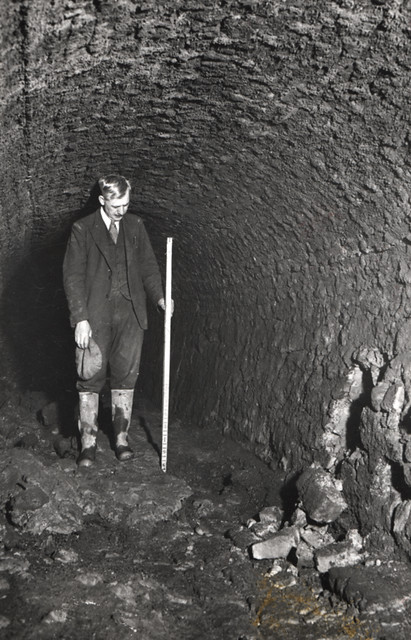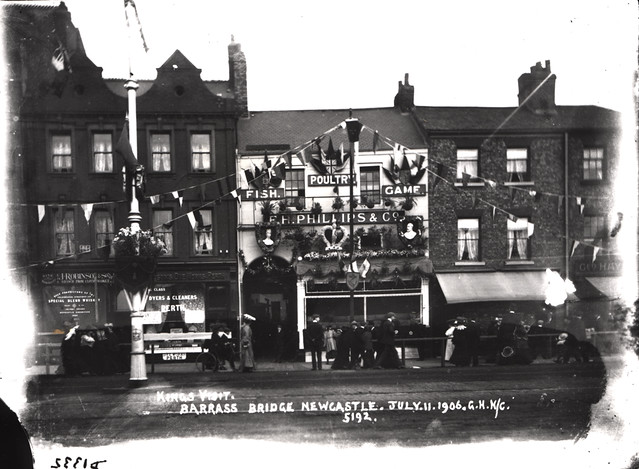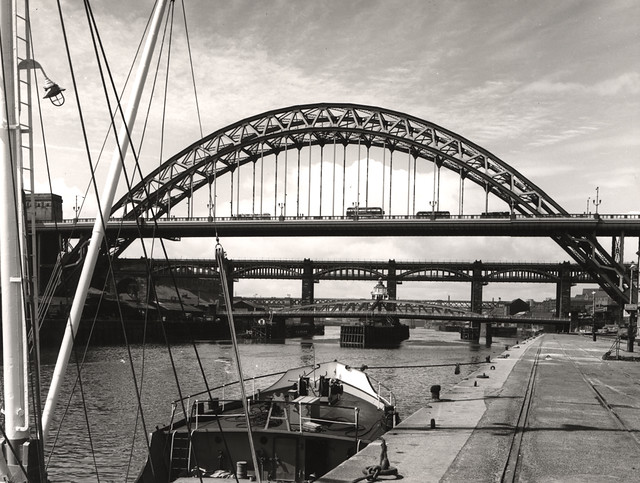Topics > Tyne and Wear > Newcastle upon Tyne > Spital Tongues > Victoria Tunnel
Victoria Tunnel
 Victoria Tunnel was built between 1839 to 1842 to carry coal from Spital Tongues Colliery to the River Tyne. The waggonway tunnel was 1½ miles (2.4km) long and had a maximum depth of 85ft (26m). The colliery closed in 1859 and the tunnel remained closed for almost 80 years until World War 2, when the section of it which ran under the centre of Newcastle was converted to be used as a bomb shelter, with a capacity of 9,000 people. (Source: SiteLines). Guided tours are organised by the Ouseburn Trust.
Victoria Tunnel was built between 1839 to 1842 to carry coal from Spital Tongues Colliery to the River Tyne. The waggonway tunnel was 1½ miles (2.4km) long and had a maximum depth of 85ft (26m). The colliery closed in 1859 and the tunnel remained closed for almost 80 years until World War 2, when the section of it which ran under the centre of Newcastle was converted to be used as a bomb shelter, with a capacity of 9,000 people. (Source: SiteLines). Guided tours are organised by the Ouseburn Trust.
Victorian wagonway
When it opened in 1835, the Leazes Main or Spital Tongues colliery was one of many coal mines around Newcastle. The Industrial Revolution was in full swing: demand for coal was high and the competition was great.
Initially, the coal was carried on carts from the colliery through the streets of Newcastle upon Tyne to the river, ready for shipping. This was slow, as the town was largely still in its medieval layout, with narrow cobbled streets (Grainger Town was still in the early stages of construction) and expensive because of the road taxes. Porter and Latimer, the colliery owners, therefore employed a local engineer, William E. Gilhespie, to construct an underground wagonway. An overground waggonway following much the same route was mooted, but the Freemen of Newcastle would not give permission for tracks to be laid across the Town Moor. A more direct route to Elswick, about two miles upstream from the mouth of the Ouseburn, was also ruled out, because the old Tyne Bridge (the Swing Bridge would not be built until 1873) prevented ships sailing beyond Newcastle. Building a staithe here would involve having to pay the keelmen to take the coal downstream of the bridge before it could be loaded into the colliers, thereby significantly reducing the profit margin on each load of coal shipped.
Construction
Permission to build the tunnel was granted in 1838 and work started the following year. The tunnel was probably dug in sections. The engineers would have excavated a shaft down to the right level then tunnelled out to link up with the next section. John Cherry was appointed to manage the tunnelling, he was a former Yorkshire Lead Miner who had previously been employed as a miner at the Leazes Main Colliery. Building works were carried out by the firm of Mr David Nixon, a builder of Prudhoe Street, Newcastle upon Tyne. Some 200 workers were employed in the construction of the Tunnel and Thomas Fordyce in his Local Records for 8 January 1841 reported 'The workmen, to the number of two hundred, were regaled with a substantial supper and strong ale, supplied by Mrs. Dixon, the worthy hostess of the Unicorn Inn, Bigg-market, Newcastle. The Albion band attended, and enlivened the joyous occasion with their music'. The walls of the tunnel were lined in stone, and a double brick arch supported the roof. It is approximately high and wide. This was just large enough to accommodate the custom-built chaldron wagons.
Transporting the coal
Because of the gradual gradient of the tunnel, loaded wagons were able to roll along a standard gauge rail track down to the river. A rope was tied to the last wagon in the train and a stationary steam engine at the top of the tunnel hauled the empty wagons back up to the pithead.
Grand opening
The Victoria Tunnel was named after the popular, young Queen Victoria. It was officially opened by the Mayor of Newcastle on 7 April 1842. A crowd of spectators including the sheriff and important merchants gathered on the quayside and at 1pm cannons were fired as a train of eight wagons appeared out of the tunnel. Four of the wagons contained coal, and the others a “company of ladies and gentlemen and a band of musicians”!
Pit closure
The Victoria Tunnel was a financial success: it reduced the cost of transporting coal from the pit to the river by 88%. The colliery, however was not a success and closed in 1860.
Having taken two and a half years to build, the Tunnel was in use for just eighteen years.
Air raid shelter
In 1939, Britain prepared for war. People were instructed to practise “Air Raid Precautions” and protect themselves from bombs dropped by the German Luftwaffe. In Newcastle, the city engineer developed plans to convert the Victoria Tunnel into a communal air raid shelter for 9000 people.
Converting the tunnel
It cost £37,000 to adapt the Tunnel into an air raid shelter. It was cleaned of coal dust and in some parts whitewashed. Several concrete blast walls were added to stop potential bomb debris flying along the tunnel. Electric lighting was fitted and a new concrete floor was laid. Wooden benches and about 500 bunk beds were installed along the walls, and chemical toilets enclosed in canvas cubicles were built near the entrances.
Seven new entrances were completed: Claremont Road, Hancock Museum, St Thomas’ Churchyard, Ridley Place, Shieldfield Green, Crawhall Road, and Ouse Street. At Ouse Street it was possible to walk straight into the tunnel, but the other access points looked like subway entrances and involved walking down a steep corridor.
Sheltering in the tunnel
There is no doubt that the tunnel was a dark, damp, and uncomfortable place to shelter. Many people were afraid to use it. Those who did remember sitting with their families and neighbours, exchanging gossip and often singing songs while waiting nervously for the “all-clear” from up above.
After the war
At the end of the war, most of the fittings were removed and all of the entrances except Ouse Street were closed. This entrance had been built on private land: the garden of number 14 Ouse Street. Guided tours are available.
Visit the page: Victoria Tunnel (Newcastle) for references and further details. You can contribute to this article on Wikipedia.
The Victoria Tunnel originally ran from the site of the Spital Tongues colliery near Hunters Road. It still exists under Claremont Road, and runs past the Hancock Museum, then close to the Civic Centre and St Mary's Place. From here it travels under Northumbria University City Campus, the Central Motorway and Shieldfield to St Dominic’s Church on the corner of Crawhall Road and New Bridge Street. It then continues under St Ann's Estate to an entrance on Ouse Street. The section of Tunnel that continued from here to the River Tyne was demolished in 1878.
Visit the page: Victoria Tunnel (Newcastle) for references and further details. You can contribute to this article on Wikipedia.
A section of the tunnel in the Ouseburn Valley is still accessible via a WWII entrance on Ouse Street. A programme of visits was first established by the Ouseburn Partnership in 1998. After a period of closure in 2006, the City Council carried out a programme of structural repairs and public safety measures, funded by the Heritage Lottery Fund and Tyne & Wear Partnership. The Victoria Tunnel Education Project developed a number of resources about the tunnel and organised public tours and school workshops from 2009. From 2010 the Ouseburn Trust has run guided tours.
A sound and light installation, commissioned from artist Adinda van 't Klooster, focuses on the themes of war, fear, and nuclear weapons, using the codenames of British military research projects as a backdrop.
Visit the page: Victoria Tunnel (Newcastle) for references and further details. You can contribute to this article on Wikipedia.

from Newcastle libraries (flickr)
034397:City Engineers in the Victoria Tunnel
Pinned by Simon Cotterill

from Newcastle libraries (flickr)
013840:Victoria Tunnel Spital Tongues c. 1900
Pinned by Simon Cotterill

from Newcastle libraries (flickr)
015089:Victoria Tunnel Barras Bridge Newcastle upon Tyne 1939
Pinned by Simon Cotterill

from Newcastle libraries (flickr)
014554: Victoria Tunnel, Second World War air raid shelter
Pinned by Simon Cotterill

from Newcastle libraries (flickr)
034427:City Engineers during maintanence on the Victoria Tunnel
Pinned by Simon Cotterill

from Newcastle libraries (flickr)
050701:VictoriaTunnel Spital Tongues Unknown 1939-45
Pinned by Simon Cotterill

Co-Curate Page
WW2 Bomb Shelters
- For domestic use, there were three main types of air-raid shelters: Anderson shelters This shelter was named after John Anderson (later Sir John), the then Home Secretary, who was responsible …

from http://www.twsitelines.info/S…
Tyne and Wear HER(4091): Newcastle, Victoria Tunnel
- "This was an underground railway built for Porter and Latimer (by William Gilhespie, local engineer) from Spital Tongues Colliery to the Tyne near Glasshouse Bridge. The lease for mining was …
Added by
Simon Cotterill

from http://www.victoriatunnel.inf…
www.victoriatunnel.info
- A Website by Phil Thirkell with a detailed history of Victoria Tunnel in its use as a wagonway and WW2 bomb shelter. It includes lots of photos, bibliography and useful …
Added by
Simon Cotterill

from https://ouseburntrust.org.uk/
Ouseburn Trust
- Ouseburn Trust lead heritage initiatives in Ouseburn valley and have managed the Victoria Tunnel since 2010. The trust runs projects to promote community involvement in Ouseburn’s heritage and development, property …
Added by
Simon Cotterill

Co-Curate Page
Waggonways
- "In the early 1600s a Nottinghamshire businessman called Huntingdon Beaumont came to Northumberland and laid rails from collieries near Blyth to a shipping point on the coast. His wooden waggonway …

Co-Curate Page
Barras Bridge
- Overview Map Street View Barras Bridge is a section of the B1318 Great North Road in the centre of Newcastle which leads towards the Haymarket and Percy Street. On the east side …

from Flickr (flickr)
Victoria Tunnels, Ouseburn. Newcastle Upon Tyne, North East England.
Pinned by Simon Cotterill

from Geograph (geograph)
Victoria Tunnel information display & entrance, Ouse Street
Pinned by Simon Cotterill

from https://historicengland.org.u…
VICTORIA TUNNEL - Newcastle - List Entry
- "Underground tramway tunnel, later used as air-raid shelter. Constructed for the Leazes Main Colliery 1839-42, converted 1939. Brick and rubble stone. This tunnel is two miles long, dropping a total …
Added by
Simon Cotterill

Co-Curate Page
Ouseburn
- "Around the Valley edges, significant and diverse populations live in Byker Wall, the St Lawrence area, St Ann’s and Battlefield estates and the Lime Square and Mariner’s Wharf developments plus …

from Flickr (flickr)
Victoria Tunnel, entrance on Claremont Road, Newcastle
Pinned by Simon Cotterill


from Newcastle libraries (flickr)
034397:City Engineers in the Victoria Tunnel
Pinned by Simon Cotterill

from Newcastle libraries (flickr)
013840:Victoria Tunnel Spital Tongues c. 1900
Pinned by Simon Cotterill

from Newcastle libraries (flickr)
015089:Victoria Tunnel Barras Bridge Newcastle upon Tyne 1939
Pinned by Simon Cotterill

from Newcastle libraries (flickr)
014554: Victoria Tunnel, Second World War air raid shelter
Pinned by Simon Cotterill

from Newcastle libraries (flickr)
034427:City Engineers during maintanence on the Victoria Tunnel
Pinned by Simon Cotterill

from Newcastle libraries (flickr)
050701:VictoriaTunnel Spital Tongues Unknown 1939-45
Pinned by Simon Cotterill

Co-Curate Page
WW2 Bomb Shelters
- For domestic use, there were three main types of air-raid shelters: Anderson shelters This shelter was named after John Anderson (later Sir John), the then Home Secretary, who was responsible …

from http://www.twsitelines.info/S…
Tyne and Wear HER(4091): Newcastle, Victoria Tunnel
- "This was an underground railway built for Porter and Latimer (by William Gilhespie, local engineer) from Spital Tongues Colliery to the Tyne near Glasshouse Bridge. The lease for mining was …
Added by
Simon Cotterill

from http://www.victoriatunnel.inf…
www.victoriatunnel.info
- A Website by Phil Thirkell with a detailed history of Victoria Tunnel in its use as a wagonway and WW2 bomb shelter. It includes lots of photos, bibliography and useful …
Added by
Simon Cotterill

from https://ouseburntrust.org.uk/
Ouseburn Trust
- Ouseburn Trust lead heritage initiatives in Ouseburn valley and have managed the Victoria Tunnel since 2010. The trust runs projects to promote community involvement in Ouseburn’s heritage and development, property …
Added by
Simon Cotterill

Co-Curate Page
Waggonways
- "In the early 1600s a Nottinghamshire businessman called Huntingdon Beaumont came to Northumberland and laid rails from collieries near Blyth to a shipping point on the coast. His wooden waggonway …

Co-Curate Page
Barras Bridge
- Overview Map Street View Barras Bridge is a section of the B1318 Great North Road in the centre of Newcastle which leads towards the Haymarket and Percy Street. On the east side …

from Flickr (flickr)
Victoria Tunnels, Ouseburn. Newcastle Upon Tyne, North East England.
Pinned by Simon Cotterill

from Geograph (geograph)
Victoria Tunnel information display & entrance, Ouse Street
Pinned by Simon Cotterill

from https://historicengland.org.u…
VICTORIA TUNNEL - Newcastle - List Entry
- "Underground tramway tunnel, later used as air-raid shelter. Constructed for the Leazes Main Colliery 1839-42, converted 1939. Brick and rubble stone. This tunnel is two miles long, dropping a total …
Added by
Simon Cotterill

Co-Curate Page
Ouseburn
- "Around the Valley edges, significant and diverse populations live in Byker Wall, the St Lawrence area, St Ann’s and Battlefield estates and the Lime Square and Mariner’s Wharf developments plus …

from Flickr (flickr)
Victoria Tunnel, entrance on Claremont Road, Newcastle
Pinned by Simon Cotterill
List grade: 2
Tyne & Wear HER: 4091
Borough: Newcastle
Grid ref: NZ2502864901
Grid ref: NZ26366410

























